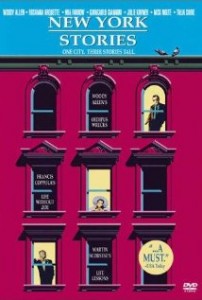From the Chicago Reader (January 16, 1998). — J.R.

Jour de fête
Rating **** Masterpiece
Directed by Jacques Tati
Written by Tati, Henri Marquet, and Rene Wheeler
With Jacques Tati, Paul Frankeur, Guy Decomble, Santa Relli, and Maine Vallee.
Every Tati film marks simultaneously (a) a moment in the work of Jacques Tati; (b) a moment in the history of French society and French cinema; (c) a moment in film history. Since 1948, the six films that he has realized are those that have scanned our history the best. Tati isn’t just a rare filmmaker, the author of few films (all of them good), he’s a living point of reference. We all belong to a period of Tati’s cinema: the author of these lines belongs to the one that stretches from Mon oncle (1958: the year before the New Wave) to Playtime (1967: the year before the events of May ’68). There is hardly anyone else but Chaplin who, since the sound period, has had this privilege, this supreme authority: to be present even when he isn’t filming, and, when he’s filming, to be precisely up to the moment — that is, just a little bit in advance. Tati: a witness first and last. Read more
From the May 29, 1998 Chicago Reader.. — J.R.

Taste of Cherry
Rating **** Masterpiece
Directed and written by Abbas Kiarostami
With Homayoun Ershadi, Abdolhossein Bagheri, Ali Moradi, Hossein Noori, and Ahmad Ansari.
I want to give the audience a hint of a scene. No more than that. Give them too much and they won’t contribute anything themselves. Give them just a suggestion and you get them working with you. That’s what gives the theatre meaning: when it becomes a social act. — Orson Welles, 1938
Much of what’s been called innovative in the art of movies over the past half century has at first been seen by part of the audience as boring or as representing a loss — usually because it has somehow redefined the shape and function of narrative. When Jean-Luc Godard introduced jump cuts in Breathless (1959) some viewers saw a loss in continuity; and when he got actors to spout literary quotations — which sometimes undercut the verisimilitude of his characters and plots — many thought he was opening the door to chaos. The next year Michelangelo Antonioni made the apparent heroine of L’avventura disappear about a third of the way through the picture and never explained what happened to her; the audience at Cannes, where the film premiered, responded with angry catcalls, insisting that the emperor had no clothes. Read more
From the Chicago Reader (March 11, 1988). —J.R.
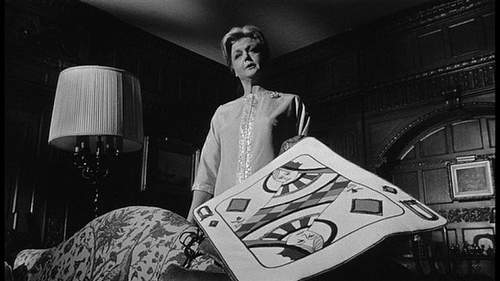
THE MANCHURIAN CANDIDATE
**** (Masterpiece)
Directed by John Frankenheimer
Written by George Axelrod
With Frank Sinatra, Laurence Harvey, Janet Leigh, Angela Lansbury, James Gregory, Leslie Parrish, John McGiver, Khigh Dhiegh, and James Edwards.
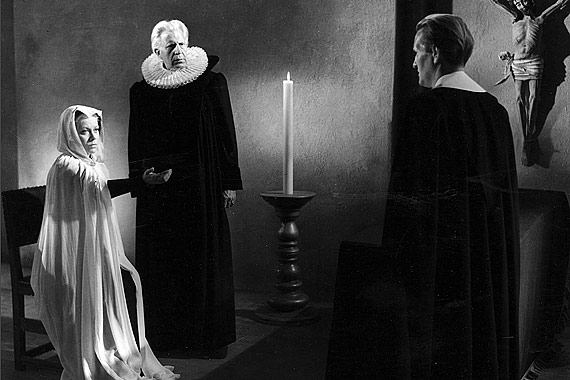
The first and only time I’ve seen a good 35-millimeter print of Carl Dreyer’s 1944 masterpiece Day of Wrath was in Europe about a month ago. The film was being rereleased, along with Dreyer’s 1925 Master of the House and his 1955 Ordet, at several small theaters in Paris, and the difference in seeing it in optimal conditions was incalculable. The carnal impact of the film’s sound track, lighting, compositions, camera movements, and performances may be dimly evident in duped 16-millimeter prints and on video, but the overall effect is like that of viewing a great painting through several layers of gauze, or hearing a great symphony through earmuffs. By and large, this prophylactic experience is the only way our film heritage is preserved for most people in the U.S. — which is another way of saying that it isn’t really preserved at all.
Why are major rereleases of old movies in spanking new prints — apart from Disney cartoon features, and the five Hitchcocks that resurfaced a few years back — such a rare occurrence in this country, and so common in France? Read more
From the January 31, 1992 Chicago Reader. — J.R.
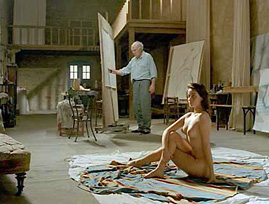
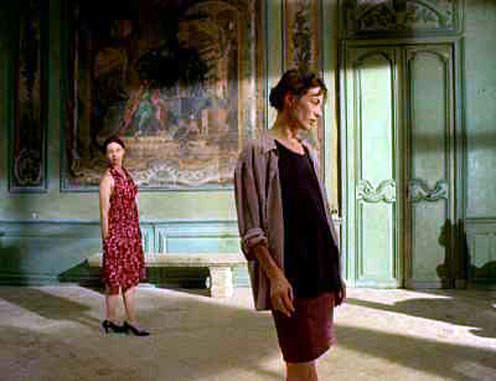
LA BELLE NOISEUSE
**** (Masterpiece)
Directed by Jacques Rivette
Written by Pascal Bonitzer, Christine Laurent, and Rivette
With Michel Piccoli, Emmanuelle Beart, Jane Birkin, David Bursztein, Gilles Arbona, Marianne Denicourt, and the hand of Bernard Dufour.
Considering how rarely the achievements of art match up with the achievements of commerce, it’s a pleasure to note that Jacques Rivette’s greatest film since 1976 (the end of his most fertile and exciting period, which began in 1968) — winner of the grand prix at last year’s Cannes film festival — also turns out to be the first commercial hit of his career. A few wags have been quick to point out that this is because the beautiful lead actress, Emmanuelle Béart (best known in this country for her part as Manon in Claude Berri’s Manon of the Spring), is nude, posing as a painter’s model, for about half of the film. Maybe they’re partially right, but it also seems to me that, without compromising or diluting his artistry, Rivette has finally hit on a subject — the collective and individual struggles that produce art and the prices that have to be paid for that art — that speaks to a wide audience. Read more
From the June 10, 1994 Chicago Reader. — J.R.
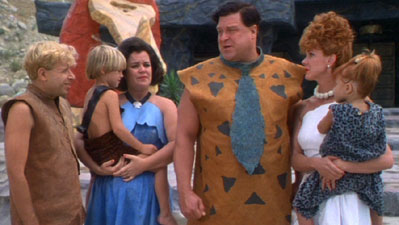
THE FLINTSTONES
* (Has redeeming facet)
Directed by Brian Levant
Written by Tom S. Parker, Jim Jennewein, and Steven E. de Souza
With John Goodman, Rick Moranis, Elizabeth Perkins, Rosie O’Donnell, Kyle MacLachlan, Halle Berry, Richard Moll, and Elizabeth Taylor.
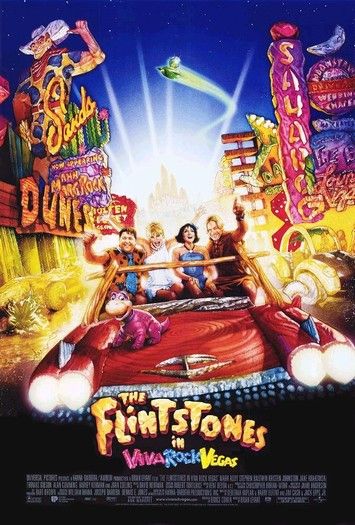
When people come to see an entertainment based on another, earlier entertainment that they have affection for, there are things about it that people want to see. They want to hear Fred yell “Yabba-Dabba-Doo!” They want to hear Wilma and Betty say “Charge It!” They want to hear Dino bark “Yip, Yip, Yip, Yip, Yip” and knock Fred down and lick him silly. And we’ve done those things because we love them, too. — Brian Levant, director of The Flintstones, quoted in the film’s pressbook
It’s quite possible that when someone writes the history of the first hundred years of movies — a period corresponding fairly closely to the 20th century — two decades of that century will be singled out as the most artistically barren: the first and the last. And the principal reasons for that barrenness may turn out to be related: in each decade film, rather than flexing its muscles as an expressive medium, was a relatively inert, inexpressive receptacle for works already fashioned, often in other media. Read more
From the Village Voice (June 1, 1982). — J.R.
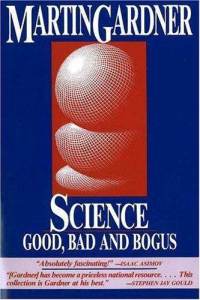
SCIENCE: GOOD, BAD AND BOGUS by Martin Gardner. Prometheus, $18.95.
As an old fan of Fads and Fallcies in the name of Science, Martin Gardner’s classic ’50s “study in human gullibility,” I’ve been looking forward to a sequel for quite some time. This collection of 38 skeptical pieces about “pseudoscience” (from Uri Geller to UFOs, by way of ESP) and “eccentric fringes” (such as black holes, catastrophe theory, and talking apes) isn’t that sequel, but it’s the next best thing — an elegant paste-up of articles and book reviews Gardner has written over the past three decades.
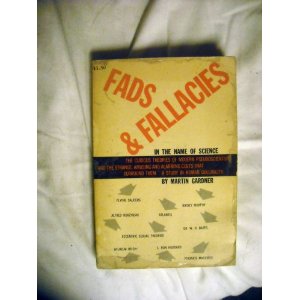
Fads and Fallacies took up a veritable rogues’ gallery of cranks, bumblers, and hustlers through the ages — like Wilbur Gleen Voliva, who thought the earth was shaped like a pancake, or Colonel Dinshah Ghadiali, whose Spectro-Chrome Therapy prescribed colored lights and a proper diet for every ailment. Thanks to the warm amusement of the man who brought us The Annotated Alice, these characters were often imbued with a certain Gogolian density even as Gardner dispassionately tore their science to shreds. Faced with his less humorous contemporaries in Science: Good, Bad and Bogus, Gardner has to forgo much of this novelistic bent — an aesthetic loss, in some ways, but also a practical gain. Read more
From Film Comment, July-August 1982. — J.R.
Movies Plus One by William S. Pechter, 246 pp., index, Horizon Press, $14.95.
Ever since certain American film critics have taken to collecting their own reviews and/or commanding their own screenings, the solipsistic nature of their profession has tended to grow. It is a tendency that crosses cult boundaries, characterizing the Neros of the profession as well as the Babbitts, the scarlet empresses as well as the Sylvia Scarletts. In her celebrated and lengthy attack on Pauline Kael in the New York Review of Books two summers ago, Renata Adler indirectly broached this problem by singling out the distressing evidence of one very gifted intelligence having run amok — a charge largely made on stylistic and rhetorical grounds, and persuasively shaped around the assumption that what was really at stake was not movies at all, but prose and the relation between writers and readers. The greatest, lasting value of Adler’s remarkable piece was its illumination of this sticky problem as a general tendency — not its ostensible project of bringing the reader the head of Pauline Kael, which gave it all its publicity.
For a wider application of what Adler was talking about, one need only turn to Kael’s arch-rival Andrew Sarris — a critic so adroit at exposing his own solipsistic stances that he’s never needed an Adler to point them out. Read more
From the May 13, 1988 Chicago Reader. — J.R.

The notion of the “testament” — the final work of a major filmmaker — is an important one to film lovers. It can be traced back to the 60s, specifically to the French New Wave and the forging in this country of the concept of the film auteur, a time when these and related phenomena were altering the official canons of movie culture. Starting next Tuesday, May 17, the Film Center of the Art Institute will present a weekly series of testaments to run through the end of June.
A lot of the movies included in “Testaments: Final Films of the Great Directors” were getting their first releases back in those days. And almost invariably, they were dying at the box office and at the hands of most mainstream reviewers, while a team of passionate and informed enthusiasts were singing their praises. Bloody religious wars were waged over these movies; in most cases, they’re still being waged.
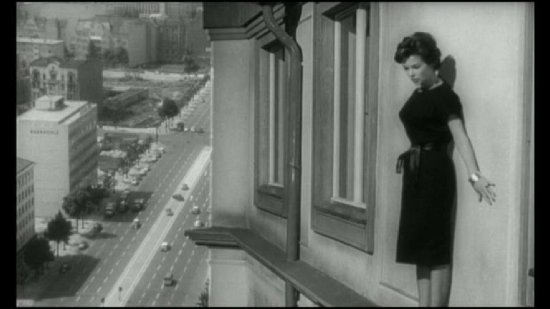
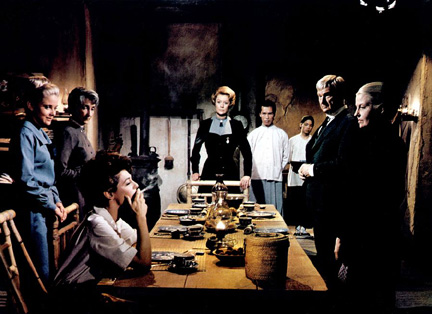
Fritz Lang’s The Thousand Eyes of Dr. Mabuse (1960), for example, and John Ford’s Seven Women (1966) are movies that separate the sheep from the goats as far as aficionados of their directors are concerned. Read more
From the Village Voice (October 10, 1974). — J.R.
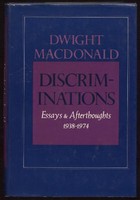
Discriminations
A book by Dwight Macdonald
Grossman, $10
by Jonathan Rosenbaum
Dwight Macdonald’s latest collection of articles is a sequel of sorts to his Politics Past — political-cultural and incidental literary criticism that composes a loose chronicle of the times, taking in a span of nearly five decades.
I blush a little to admit it today, but Dwight Macdonald was the first film critic I ever took seriously. He liked Citizen Kane, Breathless and Shadows and so did I, but I think the clincher was his prose — a rare kind of magazine writing, bursting with energy, that danced or sang or clowned regardless of what it was saying, with a fine ear for polemics and invective. This latter talent has gradually become known as his specialty. More humanistic and less of a school marm than John Simon and a lot more folksy and homespun than Gore Vidal, he shares with them the status of Master of the Chopping Block. (For the best whacks, see my favorite Macdonald collection, Against the American Grain [much of it recently reprinted, in 2011, as Masscult and Midcult: Essays Against the American Grain].) Read more
This book was published in 1977 by the British Film Institute and has been long out of print, although nearly all its contents has been reprinted on the excellent Jacques Rivette website, “Order of the Exile”. — J.R.
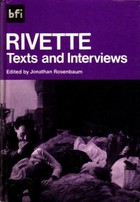
Rather than be considered in isolation, this book should be regarded as part of a general effort to make the work of Jacques Rivette available, in every sense of the term. This is not to imply that the following texts and interviews are being offered as a mere supplement to his films: if the entire body of Rivette’s work can be read as a series of evolving reflections on the cinema, the critical work contained in this volume is indissolubly linked with the critical work represented by his film-making. From this standpoint, it is not enough to say (for instance) that Rivette’s 1957 review of Fritz Lang’s Beyond a Reasonable Doubt helps to ‘explain’ — indeed, provides a veritable blueprint for — many of the preoccupations of his 1976 film Noroit. One of the assumptions of this collection is that it might be equally valuable to view Noroit as a key towards understanding Rivette’s important text on Lang. Read more
Trevor Vartanoff, one of the frequenters of this web site, has just come up with an invaluable gift to me and to others — an alphabetical master index of all (or almost all) the postings here, complete with links. .#.(2024): Ooops. Here’s the correct link to the other link: https://jonathanrosenbaum.net/2023/09/a-master-index-to-this-site-with-links-as-of-october-1-2012/
***
Featured Texts:
*Corpus Callosum
*CORPUS CALLOSUM
12 Monkeys
12 and Holding
15th Annual Festival of Illinois Film and Video
2 Oxford Companion Entries (Albert Brooks and découpage)
2 or 3 Things I Know About Her
2001: A Space Odyssey
2046
20th International Tournee of Animation
29th Chicago International Film Festival: Mired in the Present
4 Little Girls
4
60s Wisdom
7 Women
8 1/2
8 Mile
84 Charlie Mopic
9 1/2 Weeks with Van Gogh
A Bankable Feast [BABETTE’S FEAST]
A Beauty and a Beast
A Bluffer’s Guide to Bela Tarr
A Breakthrough And A Throwback
A Brief History of Time
A Brighter Summer Day
A Bronx Tale
A Christmas Commodity: SCROOGED
A Cinema of Uncertainty
A Constant Forge
A Couple of Kooks [MY BEST FIEND]
A Cut Above [HENRY: PORTRAIT OF A SERIAL KILLER]
A Depth in the Family [A HISTORY OF VIOLENCE]
A Dialogue about Abbas Kiarostami’s SHIRIN
A Different Kind of Swinger [GEORGE OF THE JUNGLE]
A Different Kind of Thrill (Richet’s ASSAULT ON PRECINCT 13)
A Dry White Season
A Family Thing
A Far Off Place
A Few Eruptions in the House of Lava
A Few Things Well [A LITTLE STIFF]
A Film of the Future
A Fish Called Wanda
A Force Unto Himself [on Hou Hsiao-hsien]
A Great Day in Harlem
A History of Violence
A Home of Our Own
À la recherche de Luc Moullet: 25 Propositions
A Little Transcendence Goes a Long Way
A Lucky Day
A Major Talent [on SWEETIE]
A Man Escaped
A Midnight Clear
A Moment of Innocence
A New Leaf
A Nightmare on Elm Street 4: The Dream Master
A Page of Madness
A Perfect World
A Perversion of the Past
A Place Called Chiapas
A Place in the Pantheon: Films by Bela Tarr
A Place in the World
A Price Above Rubies
A Prophet in His Own Country [Jon Jost retrospective]
A Quirky Cowboy Classic [on THE THREE BURIALS OF MELQUIADES ESTRADA]
A Radical Idea [HALF NELSON & THIS FILM IS NOT YET RATED]
A Road Not Taken (The Films of Harun Farocki)
A Room With No View [ORPHANS]
A Russian in Hollywood [SHY PEOPLE]
A Scanner Darkly
A Short Film About Killing and A Short Film About Love
A Single Girl
A Soldier’s Daughter Never Cries
A Stylist Hits His Stride (ETERNAL SUNSHINE OF THE SPOTLESS MIND)
A Tale of Love
A Tale of Winter
A Tale of the Wind
A Tale of the Wind
A Thousand Words
A Time of Love
A Time to Lie (CROSS MY HEART)
A Time to Live and a Time to Die
A Touch of Class [GOSFORD PARK]
A Woman’s Tale
A World Apart
A Year at the Movies
A Zed and Two Noughts
A.I. Read more
From the Chicago Reader (March 3, 1989). — J.R.
NEW YORK STORIES
*** (A must-see)
“Life Lessons”
Directed by Martin Scorsese
Written by Richard Prince
With Nick Nolte, Rosanna Arquette, and Patrick O’Neal.
“Life Without Zoe”
Directed by Francis Coppola
Written by Francis Coppola and Sofia Coppola
With Heather McComb, Talia Shire, Giancarlo Giannini, Don Novello, and Selim Tlili.
“Oedipus Wrecks”
Directed and written by Woody Allen
With Woody Allen, Mae Questel, Mia Farrow, and Julie Kavner.
With the exception of the recent and disappointing Aria, there have been no films made of late that consist of thematically related sketches, compilations of episodes by one director or more. New York Stories may help make the form fashionable again. The arbitrariness of the standard running time of features, at least from an artistic standpoint, makes a good many movies needlessly padded and a few others shorter than they should be, while the difficulty in marketing shorts discourages most commercially established filmmakers from even attempting to work in the form. New York Stories came about because Woody Allen wanted to make a short and decided that incorporating it within an anthology would make it commercially feasible.
The usual argument made against sketch movies is that they’re invariably uneven — which is true enough but also rather beside the point. Read more
From the January 15, 1999 Chicago Reader. — J.R.
The Thin Red Line
Rating *** A must see
Directed and written by Terrence Malick
With Sean Penn, Adrien Brody, Jim Caviezel, Ben Chaplin, John Cusack, Woody Harrelson, Elias Koteas, Nick Nolte, John C. Reilly, Arie Verveen, Dash Mihok, John Savage, John Travolta, and George Clooney.
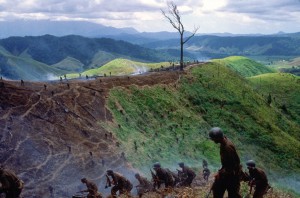
Last week the National Society of Film Critics voted Out of Sight the year’s best picture, also awarding it best screenplay and best direction. If this baffles or bemuses you, you should know that the awards in each category are chosen by multiple ballots listing three titles in order of preference. What now seems like a collective preference for a sexy thriller over more ambitious pictures was in effect a tie-breaker between two irreconcilable positions.
As a participant in the meeting I saw partisans of Steven Spielberg’s Saving Private Ryan square off against partisans of The Thin Red Line, Terrence Malick’s first film since Days of Heaven (1978). Practically no one voted for both — only Michael Wilmington of the Chicago Tribune comes to mind — so Steven Soderbergh lurched forward as a second choice, finally copping 28 votes while Spielberg and Malick tied for second place with 25 votes apiece. Read more
My 1973 Cannes coverage for London’s Time Out (which ran in their June 8-14 issue, about a year before I moved to London from Paris), slightly tweaked. I’m pretty sure I submitted something longer and more detailed (judging from my penultimate sentence, my account of Jerry Schatzberg’s Scarecrow must have been one of the several things that was cut), but I no longer have the original version to verify this. — J.R.
May 11: Discounting Godspell, the opening film, which I avoided seeing yesterday both for its sake and for mine, the festival got off to a rousing start today with two strong and absorbing films.
Joseph Losey’s A Doll’s House -– shown in the official festival, out of competition — cannot however be considered a successful embodiment of the Ibsen play. The authorial agendas of Ibsen, Losey, and [Jane] Fonda ultimately diverge more than combine, and we arrive at an abrupt impasse – a torso of the play that’s still missing a head.
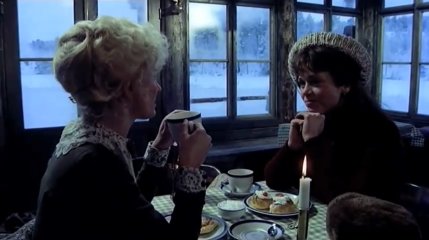
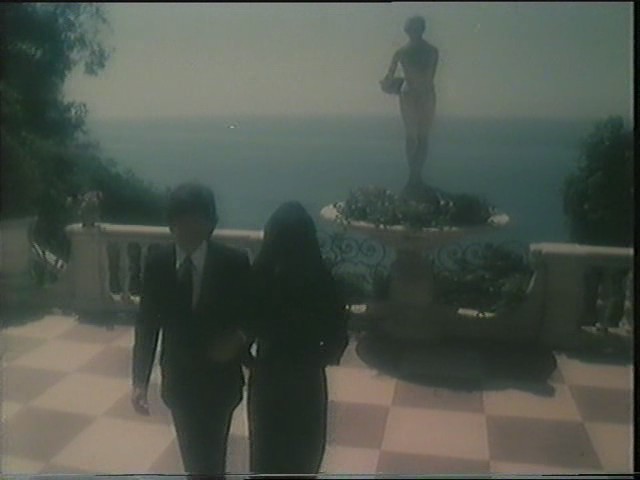
‘To waken the sleeping beauty,’ says a carnival barker in James B. Read more
From the Chicago Reader (August 4, 1989). This was my second column about Do the Right Thing; my first one is here. — J.R.

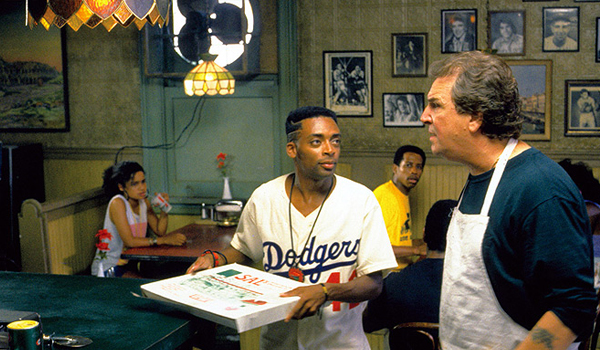
It’s readily apparent by now that Spike Lee’s Do the Right Thing is something of a Rorschach test as well as an ideological litmus test, and not only for the critics. It’s hard to think of another movie from the past several years that has elicited as much heated debate about what it says and what it means, and it’s heartening as well as significant that the picture stirring up all this talk is not a standard Hollywood feature. Because the arguments that are currently being waged about the film are in many ways as important as the film itself, and a lot more important than the issues being raised by other current releases, it seems worth looking at them again in closer detail. I don’t mean to review the movie a second time, but I do want to address some of the deeper questions being raised by it. Ultimately most of these questions have something to do with language and the way we’re accustomed to talking about certain things — race relations and violence as well as movies in general.
Read more
















